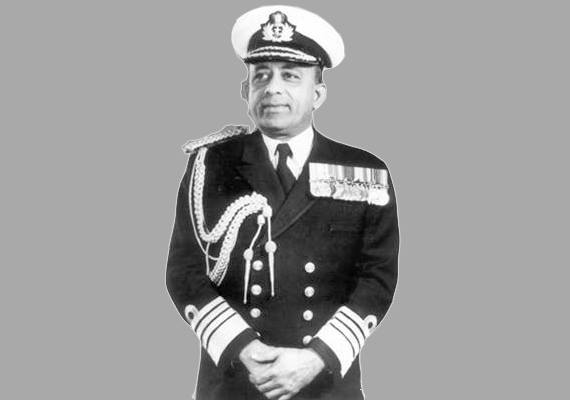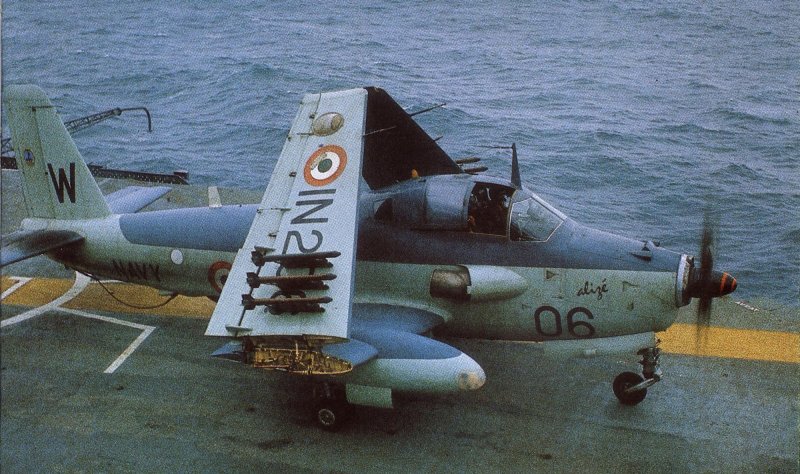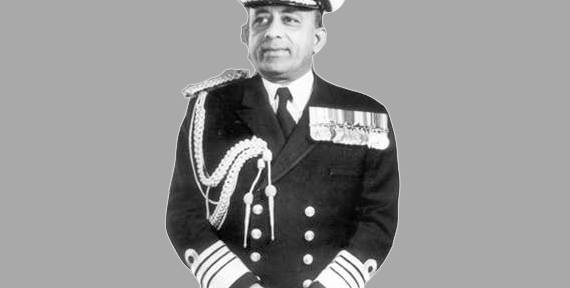Southern Naval Command has had some really nice gentlemen as C-in-C’s. Also, it had some toughies: Vice Admiral Ronnie Pereira was the Area Commander or FOCSOUTH before it became a command. And then there was Vice Admiral Oscar Stanley Dawson. When he died on the 23rd Oct 2011 in Bangalore at the age of 87, we were all saddened. The reason was that Dawson represented the last of the Admirals of the Indian Navy who had Navy as their first and last love. In his case it was true in another manner too since he died a bachelor. Dawson also represented that breed of senior officers who carried a very hard exterior but a heart of gold. He was simply consistent about his first and only love: the Indian Navy.
The thing with people like Dawson was that they assumed that everyone else was a bachelor too and had nothing else to do but to live for the Indian Navy 24/7 and all hours of day and night. As C-in-C South in Cochin, for example, he had a Commanding Officer report to him in Dress No 2s (ceremonial) for his maid-servant not knowing where saab was when C-in-C phoned his house. His reasoning went like this: “What’s the point in giving you residential phones if I cannot contact you when I want to?”
Even though it had been a few years since the dacoit movie Sholay had been released, people affectionately compared him as C-in-C South with Gabbar Singh of Sholay and often repeated the memorable dialogue of the movie by replacing Gabbar with Dawson, viz, “Dawson se tumhen ek hi aadmi bacha sakta hai, vo hai Dawson.” And I can vouch for many hard boiled commanding officers wetting their pants, at a distance of Pachaas, pachaas kos door from Cochin at the mere mention of his name.
Dawson was convinced that people go to sea to have a “jolly good time”. Hence, his logic went, their lives should be made miserable when they return to harbour for the erroneously worded R&R (Rest and Recreation). Anyone entering Cochin during his tenure as C-in-C knew that it would have been centuries (probably Before Christ) when anyone in Dawson family ever had rest and recreation.
Most often than not R&R was translated by Admiral Dawson as Ragraa and more Ragraa. Many wanted to avoid Cochin and sail directly for Bombay whilst crossing from East to West coast and vice-versa. But, Dawson quickly got them out of such vain fantasies and to reality of having to enter his command.

If you were a ship entering Cochin after days of sailing under tough conditions, your misery would start from the evening before entering Cochin harbour. First the Alizes would come and buzz you from INS Garuda, India’s First Naval Air Station commissioned in May 1953, eight years before the Navy acquired its first aircraft carrier INS Vikrant. Coinciding with the acquisition of INS Vikrant, the Indian Navy acquired ASW aircraft Alizes from the French, which were formed into 310 Cobra squadron. One year earlier, the Indian Navy also acquired the British Sea Hawks Fighter aircraft which constituted the 300 White Tiger squadron.
The Alizes were largely used for ASW (Anti Submarine Warfare) role but could also be used for reconnaissance and bombing (68mm) and AS 12 Anti-ship missiles. In the 1961 Liberation of Goa from the Portuguese, Alizes were used for reconnaissance and patrol and during the 1971 Indo-Pakistan war, they were used for both ASW patrols and in anti-surface role.

In case you survived attack by the Alizes, Dawson would have the helicopters based at Garuda to slam the daylights (or night-lights depending upon the time) out of you.
And then, no sooner that you would have secured alongside (it wasn’t easy coming alongside in Cochin due to currents and winds) that the underwater saboteurs and craft would be ready to make you feel welcome by attacking you from underwater and attaching such lovely contraptions to your underwater hull as limpet mines.
After finishing my Long Communications course at Cochin, I took over as the Signal Communication Officer of INS Talwar at Vizag. Within a day of my taking over from Deepak Agarwal, we sailed for Bombay, touching the Sri Lanka port of Trincomalee on the way. We had a lot of fun at Trinco with official reception on Himgiri and other unofficial engagements including visit to Colombo.
But, now, we were to enter Cochin and reckon with Alizes and underwater saboteurs. Talwar had the latest Electronic Warfare equipment ELT116 from Elettronica company of Italy and a multi-band radio interceptor RS160 from USA. I remained closed up in the Electronic Warfare Room throughout.
In the afternoon, under CO’s instructions, LtCdr Guha, the Electrical Officer had converted the ship to look like a merchant ship (basically altering the position of side lights (Red and Green). In a warship, these bow lights are seen ahead of the main steaming lights (White) on the foremast and the mainmast whereas a merchant ship has them aft. Similarly, warships have their Bridge ahead below the foremast whereas merchant ships have it right aft. One more difference is there in that the warships normally don’t show any lights other than these navigation lights whereas the merchant ships aren’t so careful. Guha did a very good job of the camouflage and we were sure the Alizes won’t be able to find us.
At about 2 AM, we found the Alizes though! How? First their CSF radar was intercepted on ELT 116. Then their unrestricted natter was being picked up on RS 160 clearly. I must add here that time and again in exercises it has been proved that the air boys are not very discreet with their communications assuming that since they are alone in the sky in silent hours, no one can eavesdrop on them. They also speak in PL (Plain Language) to obtain reassurance from each other.
I reported the fact of their interception to CO Cdr AR Dabir and gave him snippets of their natter. He told me to record it.
On entering Cochin at I.N. Jetty, within an hour we were called for the debrief of last night’s Exercise Hamla. This was the C-in-C’s opportunity to chew our balls for having slept over when the Alizes attacked us.
Now, I have noticed that the debriefs of exercises are often much more impressive than the exercises; especially when the debrief is being held in the hallowed premises of SMWT (School for Maritime Warfare and Tactics; which I had the privilege to command many years later). The plans are displayed and you don’t find a flaw in those. Then SMWT gives out the conduct the exercise and lessons learnt and then the concerned forces are asked to speak just for five minutes each. SMWT must have been very faithful to Dawson because they ripped us apart. The buzz in the auditorium was that Dawson would have us for lunch.
In the end, AR Dabir got up to speak. I had already given the cassette of the Alize recording to the SMWT staff. As soon as he took the podium, the natter was loud and clear in the auditorium.
Cobra One to Cobra Leader: We have a contact on the horizon; do you have it too?
Cobra Leader to Cobra One: Affirmative; I have it too. What does it look like?
Cobra One: To me it looks like solidified salt at this hour of the night.
Cobra Leader: Yes, its lights are clearly visible now; some merchant ship.
Cobra One: But where is that damned Talwar?
Cobra Leader: I won’t be surprised if the sea has devoured it for keeping us awake at this hour of night.
Cobra One: Request instructions.
Cobra Leader: Return to base. We did our best trying to find it.
There was total silence in the auditorium. But, we could clearly hear the heartbeat of the CO of the Cobra Squadron!
Balls got chewed, that day too, by Admiral Dawson. Fortunately, ours were intact.

Dear Sunbyanyname, Wonderful pieces and a flair for writing. As a child of the Navy I thoroughly enjoyed your articles especially as I knew many of the characters back in the 1960s to 1980s as friends and colleagues of my father (Late Prakash Gour 50036T, retd as RA served 1951 to 1990). In 1953 my Dad was undertraining on a British carrier HMS Triumph (Colossus class). The Indian midshipmen didn’t want the boredom of Sunday church service on the deck so convinced the XO that they will hold their own ‘church service’ in the wardroom. And so it was. The XO would peep in every Sunday and see the midshipmen singing, clapping hands and swaying. He would return satisfied that ‘oriental hymns were in progress’ (as recorded by him in the ships log). The blighters were playing ‘Antakshri’. and so it went on for 9 months.
Thank you Vivek for liking my posts. You have added a gem of an anecdote about your father. I didn’t come across him during my tenure from 1973 to 2010; but that’s my loss. I hope you’d be a regular visitor here.
Nice write up i had met admiral Dawson on board INS neelgeri for a breef movement as submariner Now retired,it was wounderful of you discribing coghin harbour and comming alonside.
Thank you. I am glad you enjoyed the write-up.
Wonderful write- up Sir. Brilliant one
Thank you Jaswant
Lovely anecdote sir. Beautifully narrated as always. All the best
Thank you Sanjay
Thank you